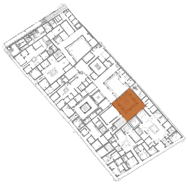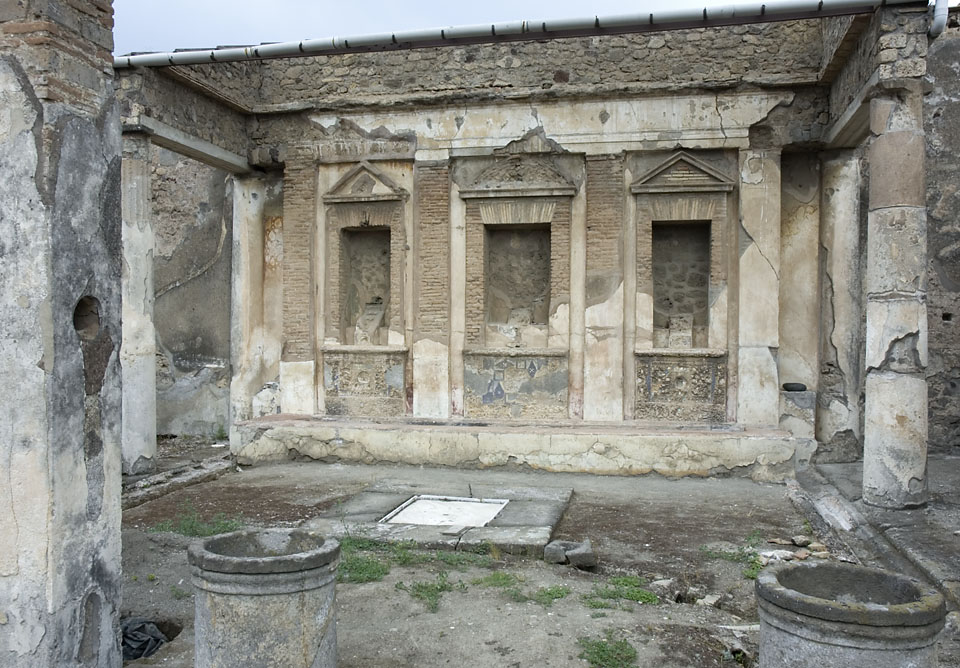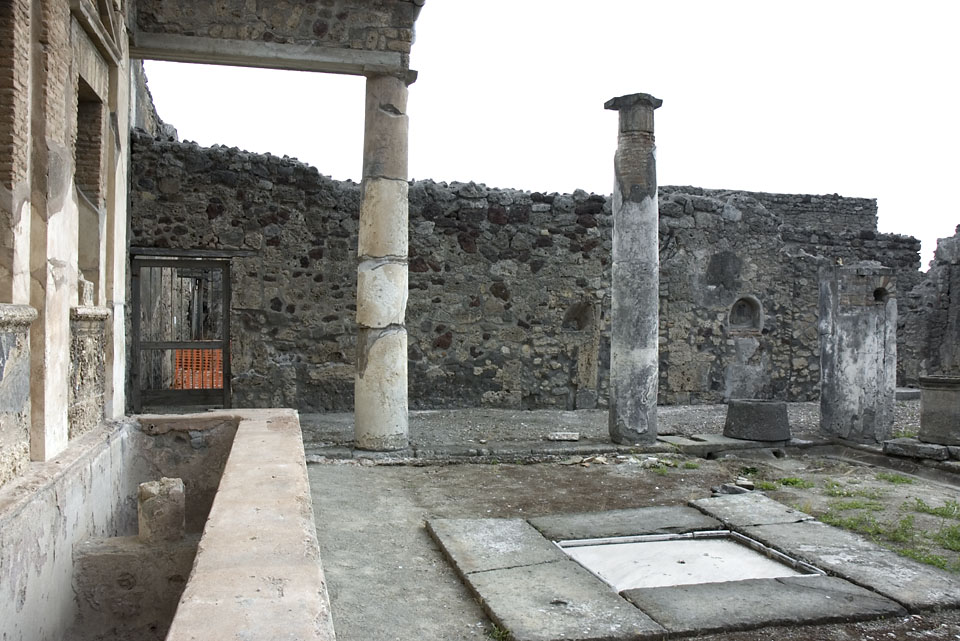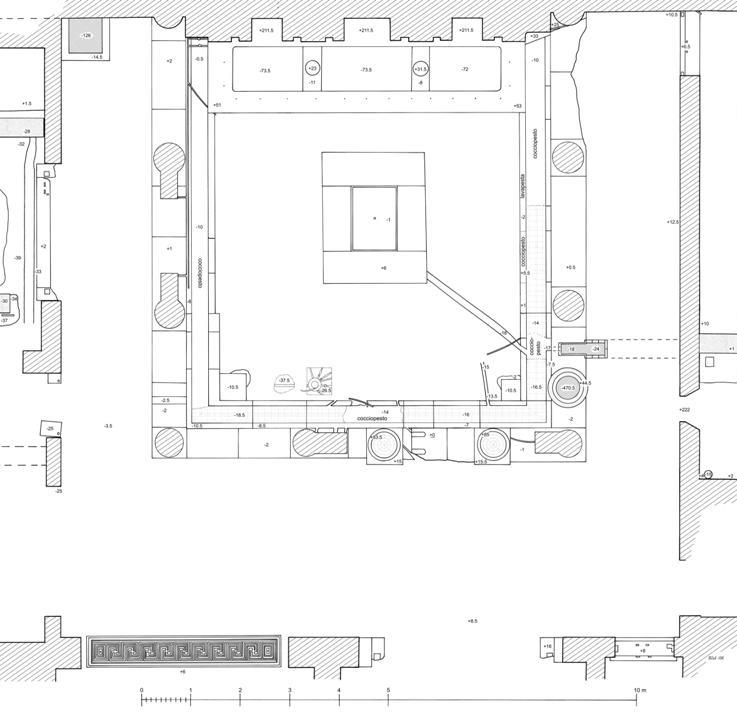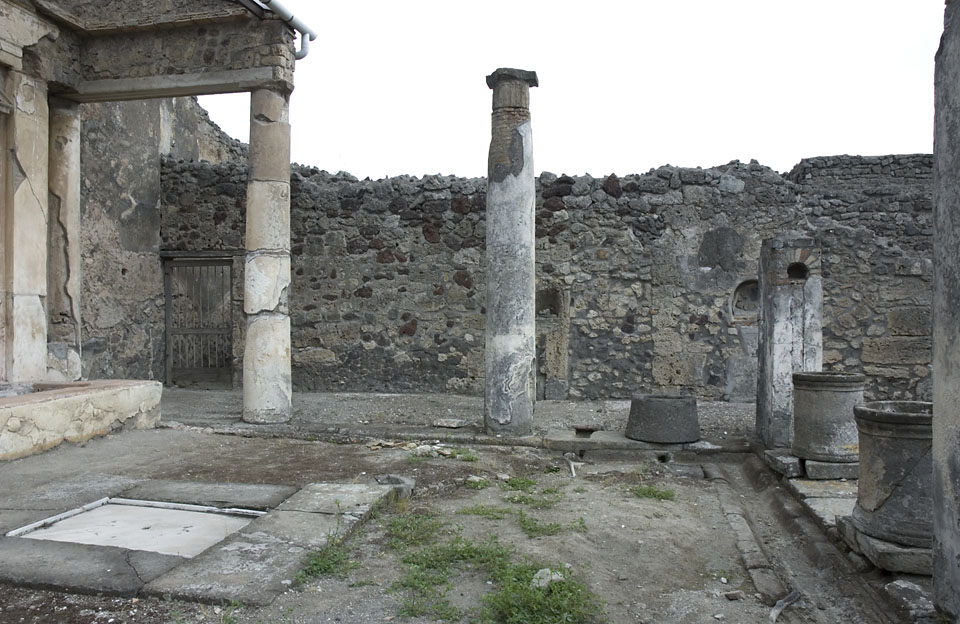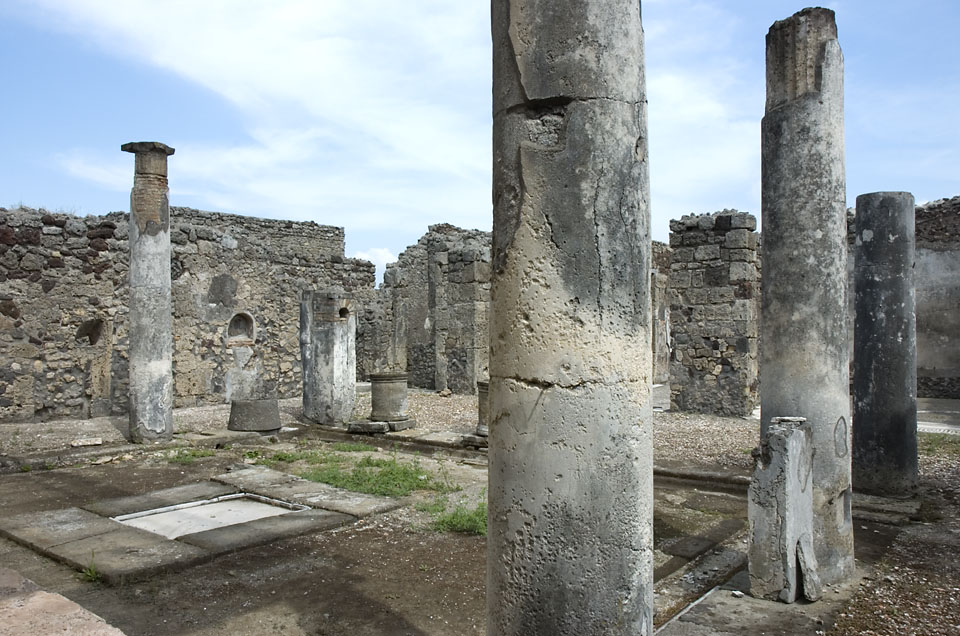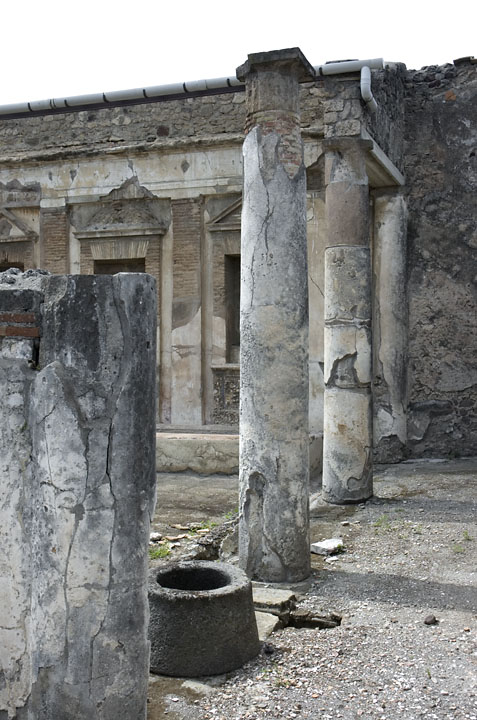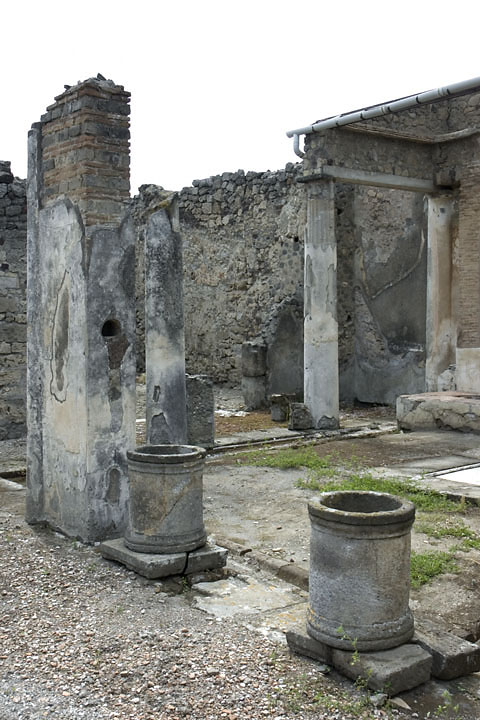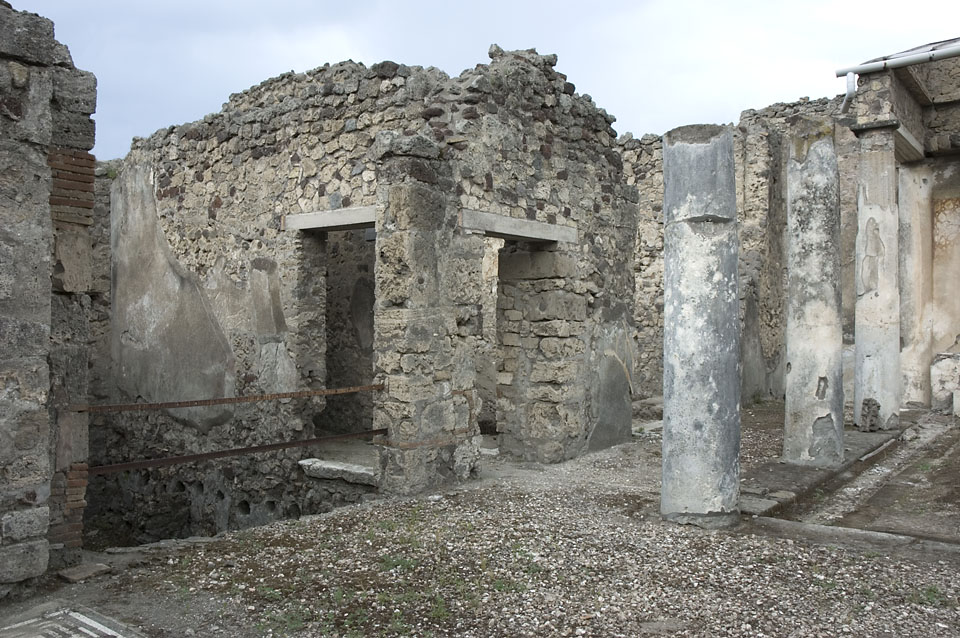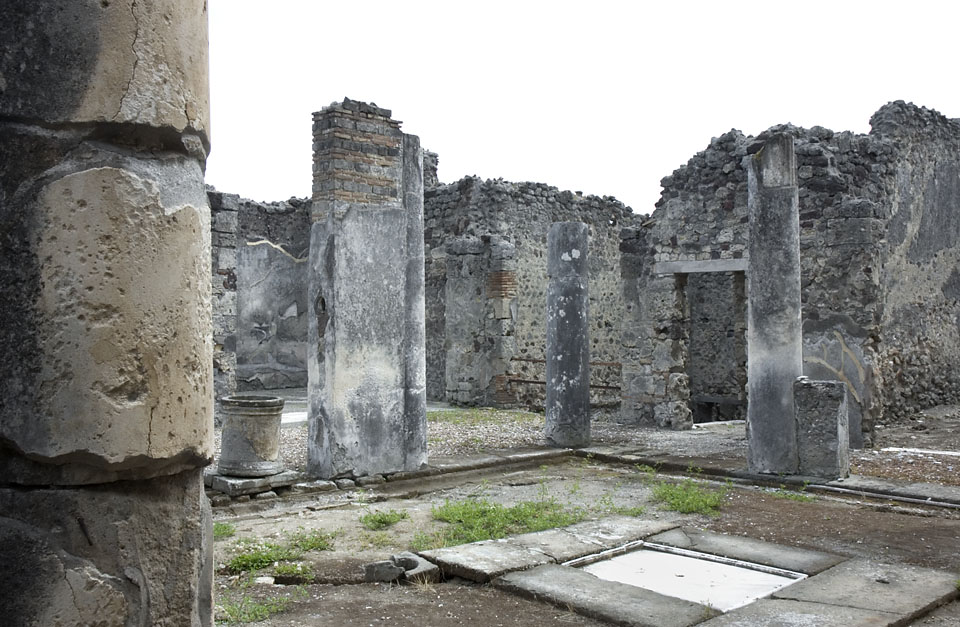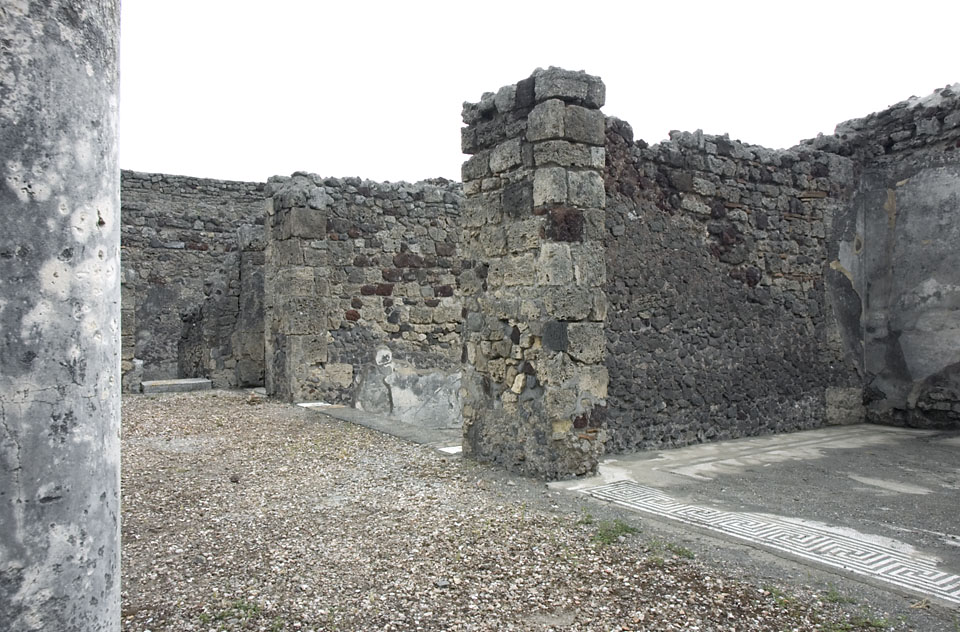Room b (peristyle)
Description
Thomas Staub
The rear part of the house is dominated by the pseudoperistyle, equipped with porticoes on three sides and with a large, three parted fountain facade on its northern side. On the south and west side, several rooms open up towards the peristyle, whereas the east side, at least in the last stage of its life, shows only the opening towards the rear entrance of the house (V 1,9) and the access to the stairs leading to an upper floor (room 12). The north side consists of the unbroken partition wall towards the Casa di Caecilius Iucundus (V 1,26). Much of the walls in the peristyle are heavily repaired or reconstructed in modern times, so that it sometimes is impossible to discern the details of the ancient structures. On most of the east wall, remains of the oldest type of incertum, i.e., lava incertum set into a reddish mortar, is visible. The same material can be found on both sides of the large nymphaeum in the north wall and in the lower parts of the narrow wall stripes on both sides of the entrance towards tablinum13 on the south side. On the west wall this material is only recognisable at the northernmost part, between the northwestern corner and the northern frame of an older, later sealed-up doorway north of the actual door towards room g. Otherwise this wall was built with a more mixed incertum, set into a yellowish mortar with smaller Sarno stone blocks (surface up to 0.4 m x 0.4 m) and bricks (southwestern corner) as doorposts.
On the east wall, two niches can be observed, both in the south part of the wall, between 1.05 and in 1.15 m height. The northern one contains a terracotta hand basin, originally probably with a drain in the bottom. This can still be seen in the PPM article, Sampaolo 1991, 526 f with fig. 90. Since this photograph was made, new restorations have been carried out, with the result that the basin nowadays is sitting aslant in the wall, with parts covered by modern concrete. A rectangular, vertical gutter continues underneath the floor of the peristyle, probably serving as drain for the used water. The southern niche served as a Lararium and still showed some remains of the wooden frieze that was framing it when it was excavated and nails to attach three statuettes (Mau 1876, p.148).
In the northwestern corner of the peristyle, a rectangular opening leads towards a vaulted cellar (ca. 2 m x 1.5 m). Remains of the drainage pipe coming from the lower west side corner of the basin in front of the nymphaeum passed through the cellar.
The garden area in the centre of the peristyle is ca. 6.15 m (N-S) x 5.8 m with a shallow marble basin (0.88 m x 1.20 m), framed by tufa slabs, in the centre of its northern part. The centre of attraction of the peristyle is the richly ornate fountain facade on its north wall (For this nymphaeum, see Neuerburg 1965, 121-122, and Andersson 1990, 221 — 224). The nymphaeum consists of three niches with one water outlet in each, separated from each other by pilasters. Pediments crown the lateral niches, whereas the central one has an arch. Mosaics, using black and white marble tesserae, small pieces of Egyptian blue, pumice, shells, glass shards and twisted glass rods, adorn the front sides under the niches (For this mosaics, see Sear 1977, 60-61). The frames of the niches and the wall areas in between are decorated with paintings imitating marble, the lateral pilasters with painted palm branches and shields and each of the two central pilasters with a depiction of a statue of a nymph, holding a shallow water basin in her arms. A watercolour by L. Mazzani, showing the nymphaeum in a slightly better state of conservation than today, was published by Maiuri 1929, 40.
In front of the nymphaeum an approx. 1.25-m-deep (upper rim ca. 0.51 m over the garden level) basin served as the receiver for the water from the fountains, both of the nymphaeum façade and from the 17 water jets along the upper side of its walls. The basin itself is divided into three parts by two roughly 0.6-m-high partitioning walls, each crowned by a small column or base whose original height cannot be established, since the uppermost parts are missing. The three sections were linked by lead pipes 0.08 - 0.1 m above the bottom (Andersson suggested fish were kept in this basin, Andersson 1990, 223). The outside of the basin walls was decorated with garden paintings framed by yellow trellises. The painted birds have been identified as those living in reed-beds and marshes (Identification made by A. Tammisto, see Andersson 1990, 230, n. 83). On the east side of the basin a lead pipe, continuing towards east along the north wall of room d and ending at the Posticum door V 1, 9, above the side street, served as an overflow outlet.
The porticoes on the west and east sides both have three columns (including the south corner columns) and one half column at the north wall, with 2.3 - 2.35 m wide intercolumnia, standing on a stylobate made of tufa slabs. Holes on the exterior sides of the columns and the half column at 0.57 - 0.62 m height, some with preserved remains of iron, probably indicate that either garlands or railings connected the columns with each other and making entry into the garden area from these sides difficult. On the two central columns of the west portico, two further iron remains at a height of 1.97 m on the internal side (i.e., towards the garden) could be remains of nails, onto which another garland could have been attached. The same can be observed on the first column to the north of the corner column of the east portico. On the second one, modern repairs cover the corresponding area, obscuring the original state.
At the final state of their existence, the south porticoes had only three columns: a fourth one between the southeastern corner column and the following one to the west might have been taken away when the fountain arrangements in the guise of two shear walls were erected against these two columns. The fountains consisted of one water jet on the side towards the intercolumnium of each of these two shear walls, placed at a height of around 1.65 m, spouting their water into two tufa drums placed on the stylobate slabs in front of them. These fountains where first identified by Andersson, 1990, 218 f. Before that, the pipes still visible in the niches on the front side of the walls had not been observed and the tufa drums were mostly interpreted as large flowerpots (Viola 1879, 26 and Jashemski 1979, 45) or puteal (Pernice 1932, 15, 22, 68). The intercolumnium between the S-W corner column and the adjacent one to the east is 2.15 m, the diameter of the columns ca. 0.52 m. Since the intercolumnium between the southeast corner column and the first one to the west is 5.05 m, there would have been enough space for a further column in between. By eliminating this column, it was not only possible to install the fountains, but also to establish an open view axis, from the fauces3, through the atrium and tablinum towards these two fountains and further on to the central and eastern niches of the main nymphaeum wall at the northern end of the house.
The columns are made of tufa drums, covered by thick layers of plaster. In the original state, the columns were faceted up to a height of 1.3 m, above which they were fluted and at least in the lower part painted red directly on the stone, as still can be seen on one column on the west side. Only later the columns were clad with plaster concealing this older appearance. Simple square slabs crowned the columns, on the northern ones probably still in situ. The first column to the north of the southeast corner column shows an antique repair made of rounded bricks in its upper part (partly covered by plaster), crowned by a reused tufa square slab capital. The columns of the south and west portico are not preserved in their entire height and are partly reconstructed in their upper parts in modern times.
Between the southeast corner column and the one following to the north, a puteal of undecorated tufa stands above the cistern mouth of the peristyle. The cistern is at least 4.7 m deep, but for security reasons a closer study of it has not been undertaken. Just north of it, an overflow channel leads from the gutter towards the side street to the east of the house.
The west and east ambulatories are approximately of the same width, around 1.8 m, whereas the width of the southern one is slightly more than twice as wide (ca. 3.7 m). The floor was mainly covered by cocciopesto, nearly completely lost today: only the northern part of the east ambulatory is paved with a homogeneous lavapesta, probably a later repair, but since it continues under the plaster covering the northern column and the half column, it is not later than the covering of these columns with plaster. The cocciopesto even covered the stylobate, at least of the south portico, since remains of this paving can be observed under the plaster of the two corner columns and under the slabs underneath the tufa drums at the southern fountains.
At some places, the floor surface shows some repairs made with a slightly different mixture of material. This is observable in the west portico, at the place where the supply water pipe for the main distribution box runs from west to east, more or less as a prolongation of corridor h'. The same phenomenon can also be seen in the east portico, where the overflow channel just to the north of the cistern runs towards the eastern back street. In other places, mainly in the southern portico, the surface of the pavement is too destroyed to allow any observations.
In the eastern portico different stages of the covering of the gutter and its western rim towards the garden can also be observed. In a first phase the gutter was made of Sarno stone. In a second one, it was covered by cocciopesto, including the rim towards the garden. This rim was then in the latest stage heightened by a further layer, this time made of lavapesta.
No remains of wall decorations are preserved except for the ones mentioned on the nymphaeum, which clearly seem to belong to the Fourth Style. Already at the time of the excavation, according to the report by Mau, hardly any remains were preserved. He mentions only some remains of a First-Style decoration at the northern end of the left (western) portico (Mau 1976, 146: '… in tutto il resto [i.e., except for room 18] di questa parte della case le decorazioni delle pareti sono cadute, fuorchè alcuni avanzi del primo stile nell'estremità settentrionale del portico sin.“).
The wall on the eastern side of the peristyle is mostly closed, thus separating the rooms to the east from it. The two existing doors are placed at the northern and southern end of this wall: the door towards room d and posticum V 1, 9 to the north and the door towards the probable staircase 12 to the south. It seems that there were more doors in the central part of the wall during an earlier phase, which were later closed off. The modern repairs of this wall make such observations quite difficult and not always totally secure, but this issue will be taken up later. The actual rooms on this side of the house served, at least in the last stage of the history of this house, different utilitarian functions and will also be dealt with in a later chapter.
On the south side of the peristyle three doorways can be observed, the easternmost opening up towards corridor 10, connecting the atrium4 with the peristyle. Here the difference in the floor levels between the atrium and the peristyle is overcome by the sloping floor of the corridor. The other two doorways are very wide (4.2 m resp. 4.35 m), opening up towards two rooms with more representational functions, tablinum13 and oecus18.
On the western side of the peristyle, three doors open up towards the west: the central one towards a corridor (h1), leading to the kitchen area and the private baths in the west and northwestern part of the house, while the two flanking ones lead to two probable dining rooms (f and g.
This part of the house was probably excavated sometimes between 1876 and 1878, not documented.
Dimensions: 12.55 m x 12.45 - 12.65 m = 157.5 m2

